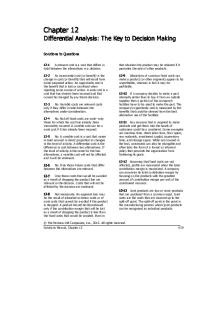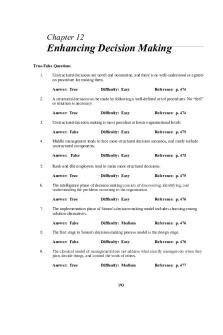14e gnb ch12 sm DOCX

| Title | 14e gnb ch12 sm |
|---|---|
| Author | Keyan Chen |
| Pages | 67 |
| File Size | 121.8 KB |
| File Type | DOCX |
| Total Downloads | 307 |
| Total Views | 421 |
Summary
Chapter 12 Differential Analysis: The Key to Decision Making Solutions to Questions 12-1 A relevant cost is a cost that differs in as a result of dropping the product is less than total between the alternatives in a decision. the fixed costs that would be avoided. Even in that situation the product ...
Description
Chapter 12 Differentialf Analfsiii hhe ees to Deciiion Making Solfutioni to Queitioni 12-1 A relevant cost is a cost that difers in total between the alternatives in a decision. 12-2 An incremental cost (or beneftt is the change in cost (or beneftt that will result from some proposed action. An opportunity cost is the beneft that is lost or sacrifced when rejecting some course of action. A sunk cost is a cost that has already been incurred and that cannot be changed by any future decision. 12-3 No. Variable costs are relevant costs only if they difer in total between the alternatives under consideration. 12-4 No. Not all fxed costs are sunk— only those for which the cost has already been irrevocably incurred. A variable cost can be a sunk cost if it has already been incurred. 12-5 No. A variable cost is a cost that varies in total amount in direct proportion to changes in the level of activity. A diferential cost is the diference in cost between two alternatives. If the level of activity is the same for the two alternatives, a variable cost will not be afected and it will be irrelevant. 12-6 No. Only those future costs that difer between the alternatives are relevant. 12-7 Only those costs that would be avoided as a result of dropping the product line are relevant in the decision. Costs that will not be afected by the decision are irrelevant. 12-8 Not necessarily. An apparent loss may be the result of allocated common costs or of sunk costs that cannot be avoided if the product is dropped. A product should be discontinued only if the contribution margin that will be lost as a result of dropping the product is less than the fxed costs that would be avoided. Even in that situation the product may be retained if it promotes the sale of other products. 12-9 Allocations of common fxed costs can make a product (or other segmentt appear to be unproftable, whereas in fact it may be proftable. 12-10 If a company decides to make a part internally rather than to buy it from an outside supplier, then a portion of the company's facilities have to be used to make the part. The company's opportunity cost is measured by the benefts that could be derived from the best alternative use of the facilities. 12-11 Any resource that is required to make products and get them into the hands of customers could be a constraint. Some examples are machine time, direct labor time, foor space, raw materials, investment capital, supervisory time, and storage space. While not covered in the text, constraints can also be intangible and often take the form of a formal or informal policy that prevents the organization from furthering its goals. 12-12 Assuming that fxed costs are not afected, profts are maximized when the total contribution margin is maximized. A © The McGraw-Hill Companies, Inc., 2012. All rights reserved. Solutions Manual, Chapter 12 639...
Similar Free PDFs

14e gnb ch12 sm
- 67 Pages

14e gnb ch12 sm - accounting
- 66 Pages

14e gnb ch08 sm
- 96 Pages

SM Ch12 - Answer Key
- 38 Pages

Ch12
- 19 Pages

Ch12
- 37 Pages

Pembentukan GNB
- 17 Pages

Ch12 - sdsdsds
- 92 Pages

TB Ch12 Capturing Surplus
- 21 Pages

Langman Embriologia Medica 14e
- 679 Pages

Chapter 16e GNB CH10 TB
- 128 Pages

ECONA231 F Exercise Ch12
- 3 Pages

CH12 Statutory Minority Protection
- 23 Pages

MIS10E testbank CH12
- 18 Pages

Yates ch12 - test bank
- 54 Pages
Popular Institutions
- Tinajero National High School - Annex
- Politeknik Caltex Riau
- Yokohama City University
- SGT University
- University of Al-Qadisiyah
- Divine Word College of Vigan
- Techniek College Rotterdam
- Universidade de Santiago
- Universiti Teknologi MARA Cawangan Johor Kampus Pasir Gudang
- Poltekkes Kemenkes Yogyakarta
- Baguio City National High School
- Colegio san marcos
- preparatoria uno
- Centro de Bachillerato Tecnológico Industrial y de Servicios No. 107
- Dalian Maritime University
- Quang Trung Secondary School
- Colegio Tecnológico en Informática
- Corporación Regional de Educación Superior
- Grupo CEDVA
- Dar Al Uloom University
- Centro de Estudios Preuniversitarios de la Universidad Nacional de Ingeniería
- 上智大学
- Aakash International School, Nuna Majara
- San Felipe Neri Catholic School
- Kang Chiao International School - New Taipei City
- Misamis Occidental National High School
- Institución Educativa Escuela Normal Juan Ladrilleros
- Kolehiyo ng Pantukan
- Batanes State College
- Instituto Continental
- Sekolah Menengah Kejuruan Kesehatan Kaltara (Tarakan)
- Colegio de La Inmaculada Concepcion - Cebu
